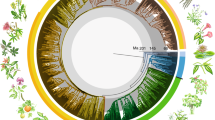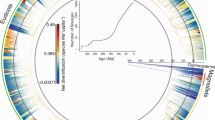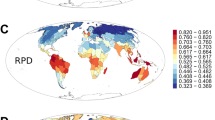Abstract
Alpine floras (plants in the vegetation belts above the climatic treelines) experience cold climates, particularly in temperate mountains during winter, but they are generally species-rich. Yet, biogeographers have not determined whether these floras represent evolutionarily independent but convergent assemblages drawn from their regional floras, or whether they originated from particular clades pre-adapted to harsh conditions. Here, we analyse the evolutionary relationships of angiosperm (flowering plant) species in 63 alpine floras worldwide (~7,000 species) in comparison with their regional floras (~94,000 species) and with the entire global flora. We find that each of the alpine floras represents an assemblage of more closely related species than their respective regional floras. The degree of phylogenetic clustering of species in alpine floras in tropical mountains exceeds that in temperate mountains. However, in relation to the global flora, temperate alpine floras are phylogenetically closely related subsets of floras that colonized cold temperate areas during interglacial periods. We conclude that alpine floras include a few dominant families that have evolved tolerance to low temperature, and that evolutionary niche conservatism explains their phylogenetic clustering, compared with species in their regional species pools.
This is a preview of subscription content, access via your institution
Access options
Access Nature and 54 other Nature Portfolio journals
Get Nature+, our best-value online-access subscription
$29.99 / 30 days
cancel any time
Subscribe to this journal
Receive 12 digital issues and online access to articles
$119.00 per year
only $9.92 per issue
Buy this article
- Purchase on Springer Link
- Instant access to full article PDF
Prices may be subject to local taxes which are calculated during checkout



Similar content being viewed by others
Data availability
The data used in this study have been published and are accessible. Details about the data sources are provided in Supplementary Table 1 or cited in the article. The data on which the analyses of this study were based are available at https://github.com/Kifir0411/NATECOLEVOL-200610646.
Change history
16 April 2021
A Correction to this paper has been published: https://doi.org/10.1038/s41559-021-01465-5
References
Lavergne, S., Mouquet, N., Thuiller, W. & Ronce, O. Biodiversity and climate change: integrating evolutionary and ecological responses of species and communities. Annu. Rev. Ecol. Evol. Syst. 41, 321–350 (2010).
Ricklefs, R. E. Community diversity: relative roles of local and regional processes. Science 235, 167–171 (1987).
Wiens, J. J. & Graham, C. H. Niche conservatism: integrating evolution, ecology, and conservation biology. Annu. Rev. Ecol. Evol. Syst. 36, 519–539 (2005).
Münkemüller, T., Boucher, F., Thuiller, W. & Lavergne, S. Common conceptual and methodological pitfalls in the analysis of phylogenetic niche conservatism. Funct. Ecol. 29, 627–639 (2015).
Behrensmeyer, A. K. et al. (eds) Terrestrial Ecosystems Through Time: Evolutionary Paleoecology of Terrestrial Plants and Animals (Univ. of Chicago Press, 1992).
Graham, A. Late Cretaceous and Cenozoic History of North American Vegetation North of Mexico (Oxford Univ. Press, 1999).
Latham, R. E. & Ricklefs, R. E. in Species Diversity in Ecological Communities (eds Ricklefs, R. E. & Schluter, D.) 294–314 (Univ. of Chicago Press, 1993).
Zanne, A. E. et al. Three keys to the radiation of angiosperms into freezing environments. Nature 506, 89–92 (2014).
Wiens, J. J. & Donoghue, M. J. Historical biogeography, ecology, and species richness. Trends Ecol. Evol. 19, 639–644 (2004).
Ricklefs, R. E. Evolutionary diversification and the origin of the diversity–environment relationship. Ecology 87, S3–S13 (2006).
Qian, H. & Sandel, B. Phylogenetic structure of regional angiosperm assemblages across latitudinal and climatic gradients in North America. Glob. Ecol. Biogeogr. 26, 1258–1269 (2017).
Körner, C. Why are there global gradients in species richness? Mountains might hold the answer. Trends Ecol. Evol. 15, 513–514 (2000).
Pulsipher, L. M. & Pulsipher, A. World Regional Geography: Global Patterns, Local Lives 6th edn (W.H. Freeman, 2014).
Culmsee, H. & Leuschner, C. Consistent patterns of elevational change in tree taxonomic and phylogenetic diversity across Malesian mountain forests. J. Biogeogr. 40, 1997–2010 (2013).
González-Caro, S., Umaña, M. N., Álvarez, E., Stevenson, P. R. & Swenson, N. G. Phylogenetic alpha and beta diversity in tropical tree assemblages along regional scale environmental gradients in northwest South America. J. Plant Ecol. 7, 145–153 (2014).
Qian, H., Zhang, Y., Zhang, J. & Wang, X. Latitudinal gradients in phylogenetic relatedness of angiosperm trees in North America. Glob. Ecol. Biogeogr. 22, 1183–1191 (2013).
Qian, H., Field, R., Zhang, J., Zhang, J. & Chen, S. Phylogenetic structure and ecological and evolutionary determinants of species richness for angiosperm trees in forest communities in China. J. Biogeogr. 43, 603–615 (2016).
Qian, H. & Ricklefs, R. E. Out of the tropical lowlands: latitude versus elevation. Trends Ecol. Evol. 31, 738–741 (2016).
Smith, S. A. & Brown, J. W. Constructing a broadly inclusive seed plant phylogeny. Am. J. Bot. 105, 302–314 (2018).
Jin, Y. & Qian, H. V.PhyloMaker: an R package that can generate very large phylogenies for vascular plants. Ecography https://doi.org/10.1111/ecog.04434 (2019).
Mazel, F. et al. Influence of tree shape and evolutionary time-scale on phylogenetic diversity metrics. Ecography 39, 913–920 (2016).
Thuiller, W. et al. Resolving Darwin’s naturalization conundrum: a quest for evidence. Divers. Distrib. 16, 461–475 (2010).
Körner, C. Alpine Plant Life: Functional Plant Ecology of High Mountain Ecosystems 2nd edn (Springer, 2003).
Mayfield, M. M. & Levine, J. M. Opposing effects of competitive exclusion on the phylogenetic structure of communities. Ecol. Lett. 13, 1085–1093 (2010).
Gallien, L., Zurell, D. & Zimmermann, N. E. Frequency and intensity of facilitation reveal opposing patterns along a stress gradient. Ecol. Evol. 8, 2171–2181 (2018).
Choler, P., Michalet, R. & Callaway, R. M. Facilitation and competition on gradients in alpine plant communities. Ecology 82, 3295–3308 (2001).
Butterfield, B. J. et al. Alpine cushion plants inhibit the loss of phylogenetic diversity in severe environments. Ecol. Lett. 16, 478–486 (2013).
Steinbauer et al. Topography-driven isolation, speciation and a global increase of endemism with elevation. Glob. Ecol. Biogeogr. 25, 1097–1107 (2016).
Takhtajan, A. L. Flowering Plants: Origin and Dispersal (Oliver & Boyd, 1969).
Ghalambor, C. K., Huey, R. B., Martin, P. R., Tewksbury, J. J. & Wang, G. Are mountain passes higher in the tropics? Janzen’s hypothesis revisited. Integr. Comp. Biol. 46, 5–17 (2006).
Heald, W. Sky Island (D. Van Nostrand Co., Inc., 1967).
Marx, H. E. et al. Riders in the sky (islands): using a mega-phylogenetic approach to understand plant species distribution and coexistence at the altitudinal limits of angiosperm plant life. J. Biogeogr. 44, 2618–2630 (2017).
Humboldt, A. V. & Bonpland, A. Essai sur la Géographie des Plantes: Accompagné d’un Tableau Physique des Régions Équinoxiales (Arno Press, 1977).
Qian, H., White, P. S., Klinka, K. & Chourmouzis, C. Phytogeographical and community similarities of alpine tundras of Changbaishan Summit, China, and Indian Peaks, USA. J. Veg. Sci. 10, 869–882 (1999).
Körner, C., Paulsen, J. & Spehn, E. M. A definition of mountains and their bioclimatic belts for global comparisons of biodiversity data. Alp. Bot. 121, 73–78 (2011).
Chapin, F. S. III & Körner, C. in Arctic and Alpine Biodiversity: Patterns, Causes and Ecosystem Consequences (eds Chapin, F. S. III & Körner, C.) 313–320 (Springer, 1995).
Angiosperm Phylogeny Group. An update of the Angiosperm Phylogeny Group classification for the orders and families of flowering plants: APG IV. Bot. J. Linn. Soc. 181, 1–20 (2016).
Webb, C., Ackerly, D. & Kembel, S. Phylocom: Software for the analysis of phylogenetic community structure and character evolution, with Phylomatic. R package version 4.2 (2011).
Qian, H. & Jin, Y. Are phylogenies resolved at the genus level appropriate for studies on phylogenetic structure of species assemblages? Plant Divers. https://doi.org/10.1016/j.pld.2020.11.005 (2021).
Faith, D. P. Conservation evaluation and phylogenetic diversity. Biol. Conserv. 61, 1–10 (1992).
Webb, C. O., Ackerly, D. D., McPeek, M. A. & Donoghue, M. J. Phylogenies and community ecology. Annu. Rev. Ecol. Syst. 33, 475–505 (2002).
Tsirogiannis, C., Sandel, B. & Cheliotis, D. Efficient computation of popular phylogenetic tree measures. Lect. Notes Comput. Sci. 7534, 30–43 (2012).
Tsirogiannis, C., Sandel, B. & Kalvisa, A. New algorithms for computing phylogenetic biodiversity. Lect. Notes Comput. Sci. 8701, 187–203 (2014).
Tsirogiannis, C. & Sandel, B. PhyloMeasures: a package for computing phylogenetic biodiversity measures and their statistical moments. Ecography 39, 709–714 (2016).
Acknowledgements
We thank F. Boucher and S. Lavergne for their constructive comments, as well as numerous collaborators and colleagues for digitized data. H.Q. acknowledges the Key Projects of the Joint Fund of the National Natural Science Foundation of China (grant no. U1802232).
Author information
Authors and Affiliations
Contributions
H.Q., R.E.R. and W.T. discussed and developed the ideas presented in the article. H.Q. analysed the data. H.Q., W.T. and R.E.R. wrote the article.
Corresponding author
Ethics declarations
Competing interests
The authors declare no competing interests.
Additional information
Peer review information Nature Ecology & Evolution thanks Christopher Dick and the other, anonymous, reviewer(s) for their contribution to the peer review of this work.
Publisher’s note Springer Nature remains neutral with regard to jurisdictional claims in published maps and institutional affiliations.
Supplementary information
Supplementary Information
Supplementary Tables 1 and 2 and Figs. 1–3.
Rights and permissions
About this article
Cite this article
Qian, H., Ricklefs, R.E. & Thuiller, W. Evolutionary assembly of flowering plants into sky islands. Nat Ecol Evol 5, 640–646 (2021). https://doi.org/10.1038/s41559-021-01423-1
Received:
Accepted:
Published:
Issue Date:
DOI: https://doi.org/10.1038/s41559-021-01423-1
This article is cited by
-
Shared-role of vegetation types, elevation and soil affecting plant diversity in an old-tropical mountain hotspot
Journal of Mountain Science (2023)
-
Altitude as environmental filtering influencing phylogenetic diversity and species richness of plants in tropical mountains
Journal of Mountain Science (2023)
-
Contrasting patterns of phylogenetic diversity and alpine specialization across the alpine flora of the American mountain range system
Alpine Botany (2022)
-
History and evolution of the afroalpine flora: in the footsteps of Olov Hedberg
Alpine Botany (2022)



